Vitamin D3 Receptors and Metabolic Enzymes in Hen Reproductive Tissues
Abstract
1. Introduction
2. Results
2.1. Transcript Abundances of VDR, PDIA3, CYP27C1, and CYP24A1 mRNA in the Hen Reproductive System
2.2. Abundances of VDR, PDIA3, 1α-hydroxylase, and 24-hydroxylase Protein in the Hen Reproductive System
2.3. Immunofluorescent Localization of PDIA3, 1α-hydroxylase, and 24-hydroxylase in the Hen Reproductive System
3. Discussion
4. Materials and Methods
4.1. Chickens and Tissue Sampling
4.2. RNA Isolation and qRT-PCR
4.3. Western Blot Analysis
4.4. Immunofluorescence
4.5. Statistical Analysis
5. Conclusions
Author Contributions
Funding
Institutional Review Board Statement
Informed Consent Statement
Data Availability Statement
Conflicts of Interest
References
- Johnson, A.L. Ovarian follicle selection and granulosa cell differentiation. Poult. Sci. 2015, 94, 781–785. [Google Scholar] [CrossRef] [PubMed]
- van der Klein, S.A.; Zuidhof, M.J.; Bédécarrats, G.Y. Diurnal and seasonal dynamics affecting egg production in meat chickens: A review of mechanisms associated with reproductive dysregulation. Anim. Reprod. Sci. 2020, 213, 106257. [Google Scholar] [CrossRef] [PubMed]
- Hrabia, A. Reproduction in the female. In Sturkie’s Avian Physiology, 7th ed.; Scanes, C.G., Dridi, S., Eds.; Academic Press: Cambridge, MA, USA, 2022; pp. 941–986. [Google Scholar] [CrossRef]
- Woods, D.C.; Johnson, A.L. Regulation of follicle-stimulating hormone-receptor mRNA in hen granulosa cells relative to follicle selection. Biol. Reprod. 2005, 72, 643–650. [Google Scholar] [CrossRef] [PubMed]
- Lorenzen, M.; Boisen, I.M.; Mortensen, L.J.; Lanske, B.; Juul, A.; Blomberg Jensen, M. Reproductive endocrinology of vitamin D. Mol. Cell. Endocrinol. 2017, 453, 103–112. [Google Scholar] [CrossRef] [PubMed]
- Muscogiuri, G.; Altieri, B.; de Angelis, C.; Palomba, S.; Pivonello, R.; Colao, A.; Orio, F. Shedding new light on female fertility: The role of vitamin D. Rev. Endocr. Metab. Disord. 2017, 18, 273–283. [Google Scholar] [CrossRef] [PubMed]
- Fichera, M.; Török, P.; Tesarik, J.; Della Corte, L.; Rizzo, G.; Garzon, S.; Carlea, A.; Di Angelo Antonio, S.; Zito, G.; Panella, M.M. Vitamin D, reproductive disorders and assisted reproduction: Evidences and perspectives. Int. J. Food. Sci. Nutr. 2020, 71, 276–285. [Google Scholar] [CrossRef]
- Grzesiak, M.; Tchurzyk, M.; Socha, M.; Sechman, A.; Hrabia, A. An overview of the current known and unknown roles of vitamin D3 in the female reproductive system: Lessons from farm animals, birds, and fish. Int. J. Mol. Sci. 2022, 23, 14137. [Google Scholar] [CrossRef]
- Hurst, E.A.; Homer, N.Z.; Mellanby, R.J. Vitamin D metabolism and profiling in veterinary species. Metabolites 2020, 10, 371. [Google Scholar] [CrossRef]
- Omara, I.I.; Mou, C.T.; Persia, M.E.; Wong, E.A. Effects of available phosphorus source and concentration on performance and expression of sodium phosphate type IIb cotransporter, vitamin D-1α-hydroxylase, and vitamin D-24-hydroxylase mRNA in broiler chicks. Poult. Sci. 2020, 99, 1822–1831. [Google Scholar] [CrossRef]
- Gloux, A.; Le Roy, N.; Ezagal, J.; Meme, N.; Hennequet-Antier, C.; Piketty, M.L.; Prie, D.; Benzoni, G.; Gautron, J.; Nys, Y.; et al. Possible roles of parathyroid hormone, 1.25(OH)2D3, and fibroblast growth factor 23 on genes controlling calcium metabolism across different tissues of the laying hen. Domest. Anim. Endocrinol. 2020, 72, 106407. [Google Scholar] [CrossRef]
- Bikle, D.D.; Patzek, S.; Wang, Y. Physiologic and pathophysiologic roles of extra renal CYP27b1: Case report and review. Bone Rep. 2018, 8, 255–267. [Google Scholar] [CrossRef] [PubMed]
- Christakos, S.; Dhawan, P.; Verstuyf, A.; Verlinden, L.; Carmeliet, G. Vitamin D: Metabolism, molecular mechanism of action, and pleiotropic effects. Physiol. Rev. 2016, 96, 365–408. [Google Scholar] [CrossRef] [PubMed]
- Hanel, A.; Carlberg, C. Vitamin D and evolution: Pharmacologic implications. Biochem. Pharmacol. 2020, 173, 113595. [Google Scholar] [CrossRef] [PubMed]
- Donati, S.; Palmini, G.; Aurilia, C.; Falsetti, I.; Miglietta, F.; Iantomasi, T.; Brandi, M.L. Rapid nontranscriptional effects of calcifediol and calcitriol. Nutrients 2022, 14, 1291. [Google Scholar] [CrossRef] [PubMed]
- Grzesiak, M.; Kaminska, K.; Bodzioch, A.; Drzewiecka, E.M.; Franczak, A.; Knapczyk-Stwora, K. Vitamin D3 metabolic enzymes in the porcine uterus: Expression, localization and autoregulation by 1,25(OH)2D3 in vitro. Int. J. Mol. Sci. 2022, 23, 3972. [Google Scholar] [CrossRef] [PubMed]
- Keane, K.N.; Cruzat, V.F.; Calton, E.K.; Hart, P.H.; Soares, M.J.; Newsholme, P.; Yovich, J.L. Molecular actions of Vitamin D in reproductive cell biology. Reproduction 2017, 153, 29–42. [Google Scholar] [CrossRef]
- Narbaitz, R.; Tsang, C.P.W.; Grunder, A.A.; Soares, J.H., Jr. Scanning electron microscopy of thin and soft shells induced by feeding calcium-deficient or vitamin D-deficient diets to laying hens. Poult. Sci. 1987, 66, 341–347. [Google Scholar] [CrossRef]
- Grzesiak, M.; Socha, M.; Hrabia, A. Altered vitamin D metabolic system in follicular cysts of sows. Reprod. Domest. Anim. 2021, 56, 193–196. [Google Scholar] [CrossRef]
- Zmijewski, M.A.; Carlberg, C. Vitamin D receptor(s): In the nucleus but also at membranes? Exp. Dermatol. 2020, 29, 876–884. [Google Scholar] [CrossRef]
- Hii, C.S.; Ferrante, A. The non-genomic actions of vitamin D. Nutrients 2016, 8, 135. [Google Scholar] [CrossRef]
- Grzesiak, M.; Knapczyk-Stwora, K.; Slomczynska, M. Vitamin D3 in ovarian antral follicles of mature gilts: Expression of its receptors and metabolic enzymes, concentration in follicular fluid and effect on steroid secretion in vitro. Theriogenology 2021, 160, 151–160. [Google Scholar] [CrossRef] [PubMed]
- Dokoh, S.; Donaldson, C.A.; Marion, S.L.; Pike, J.W.; Haussler, M.R. The ovary: A target organ for 1, 25-dihydroxyvitamin D3. Endocrinology 1983, 112, 200–206. [Google Scholar] [CrossRef] [PubMed]
- Wojtusik, J.; Johnson, P.A. Vitamin D regulates anti-Mullerian hormone expression in granulosa cells of the hen. Biol. Reprod. 2012, 86, 91. [Google Scholar] [CrossRef] [PubMed]
- Ieda, T.; Saito, N.; Ono, T.; Shimada, K. Effects of presence of an egg and calcium deposition in the shell gland on levels of messenger ribonucleic acid of CaBP-D28K and of vitamin D3 receptor in the shell gland of the laying hen. Gen. Comp. Endocrinol. 1995, 99, 145–151. [Google Scholar] [CrossRef] [PubMed]
- Yoshimura, Y.; Ohira, H.; Tamura, T. Immunocytochemical localization of vitamin D receptors in the shell gland of immature, laying, and molting hens. Gen. Comp. Endocrinol. 1997, 108, 282–289. [Google Scholar] [CrossRef]
- Ruschkowski, S.R.; Hart, L.E. Ionic and endocrine characteristics of reproductive failure in calcium-deficient and vitamin D-deficient laying hens. Poult. Sci. 1992, 71, 1722–1732. [Google Scholar] [CrossRef]
- Kundu, M.C.; Wojtusik, J.; Johnson, P.A. Expression and regulation of Kit ligand in the ovary of the hen. Gen. Comp. Endocrinol. 2012, 179, 47–52. [Google Scholar] [CrossRef]
- Pawłowska, K.; Sechman, A.; Suchanek, I.; Grzegorzewska, A.; Rząsa, J. Effect of 9-cis retinoic acid (RA) on progesterone and estradiol secretion and RA receptor expression in the chicken ovarian follicles. Folia Biol. 2008, 56, 65–72. [Google Scholar] [CrossRef][Green Version]
- Yao, X.; Wang, Z.; El-Samahy, M.A.; Ren, C.; Liu, Z.; Wang, F.; You, P. Roles of vitamin D and its receptor in the proliferation and apoptosis of luteinised granulosa cells in the goat. Reprod. Fertil. Dev. 2020, 32, 335–348. [Google Scholar] [CrossRef]
- Nys, Y.; Gautron, J.; Rodriguez-Navarro, A.B.; Hincke, M. Mechanisms and hormonal regulation of shell formation: Supply of ionic and organic precursors, shell mineralization. In Sturkie’s Avian Physiology, 7th ed.; Scanes, C.G., Dridi, S., Eds.; Academic Press: Cambridge, MA, USA, 2022; pp. 833–879. [Google Scholar] [CrossRef]
- Bar, A. Calcium transport in strongly calcifying laying birds: Mechanisms and regulation. Comp. Biochem. Physiol. Part A Mol. Integr. Physiol. 2009, 152, 447–469. [Google Scholar] [CrossRef]
- Corradino, R.A. Calbindin D28K regulation in precociously matured chick egg shell gland in vitro. Gen. Comp. Endocrinol. 1993, 91, 158–166. [Google Scholar] [CrossRef] [PubMed]
- Stenhouse, C.; Halloran, K.M.; Moses, R.M.; Seo, H.; Gaddy, D.; Johnson, G.A.; Wu, G.; Suva, L.J.; Bazer, F.W. Effects of progesterone and interferon tau on ovine endometrial phosphate, calcium, and vitamin D signaling. Biol. Reprod. 2022, 106, 888–899. [Google Scholar] [CrossRef] [PubMed]
- Hrabia, A.; Wolak, D.; Kowalik, K.; Sechman, A. Alterations in connexin 43 gene and protein expression in the chicken oviduct following tamoxifen treatment. Theriogenology 2022, 188, 125–134. [Google Scholar] [CrossRef] [PubMed]
- Grzesiak, M.; Waszkiewicz, E.; Wojtas, M.; Kowalik, K.; Franczak, A. Expression of vitamin D receptor in the porcine uterus and effect of 1,25(OH)2D3 on progesterone and estradiol-17β secretion by uterine tissues in vitro. Theriogenology 2019, 125, 102–108. [Google Scholar] [CrossRef]
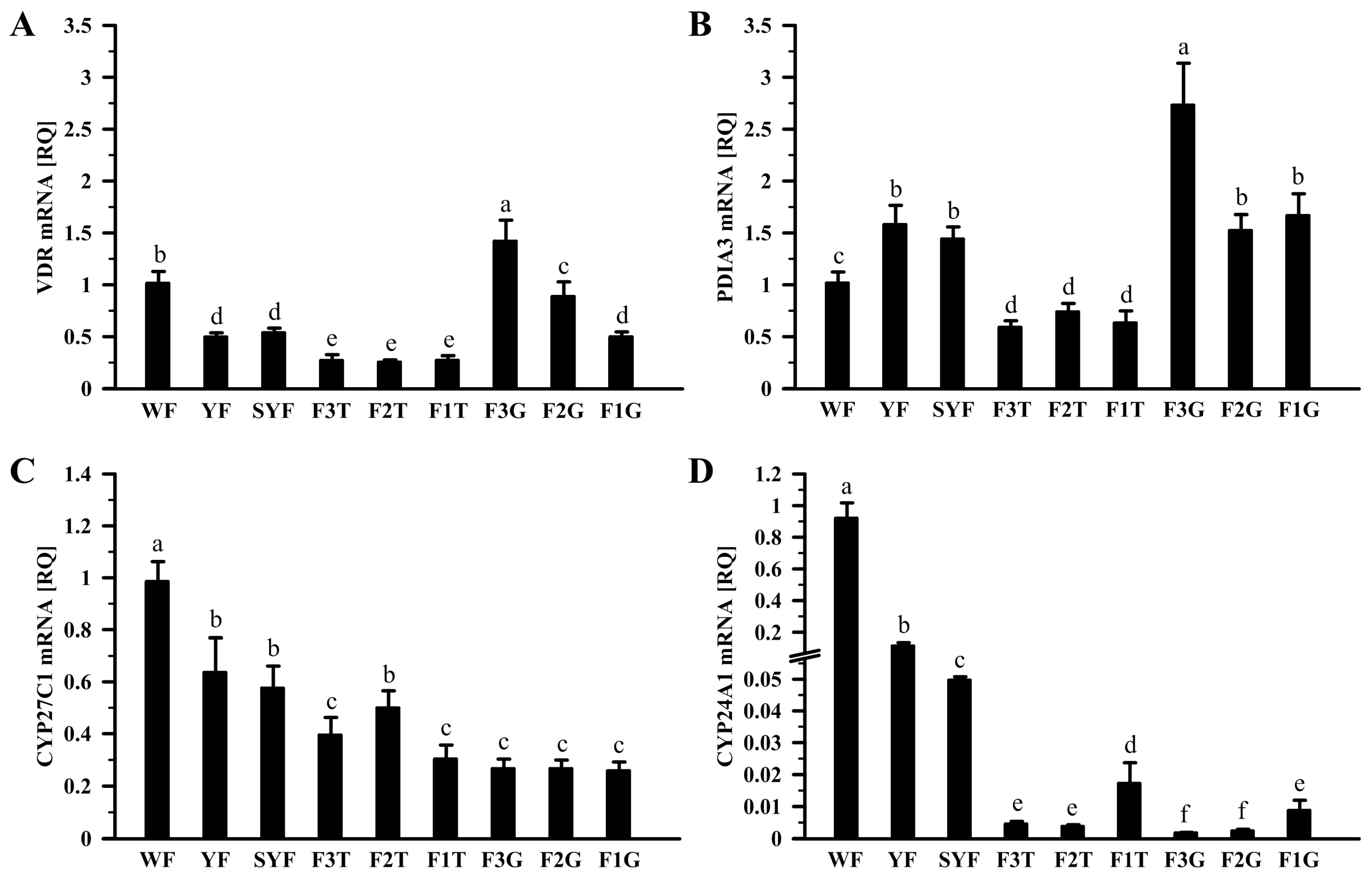

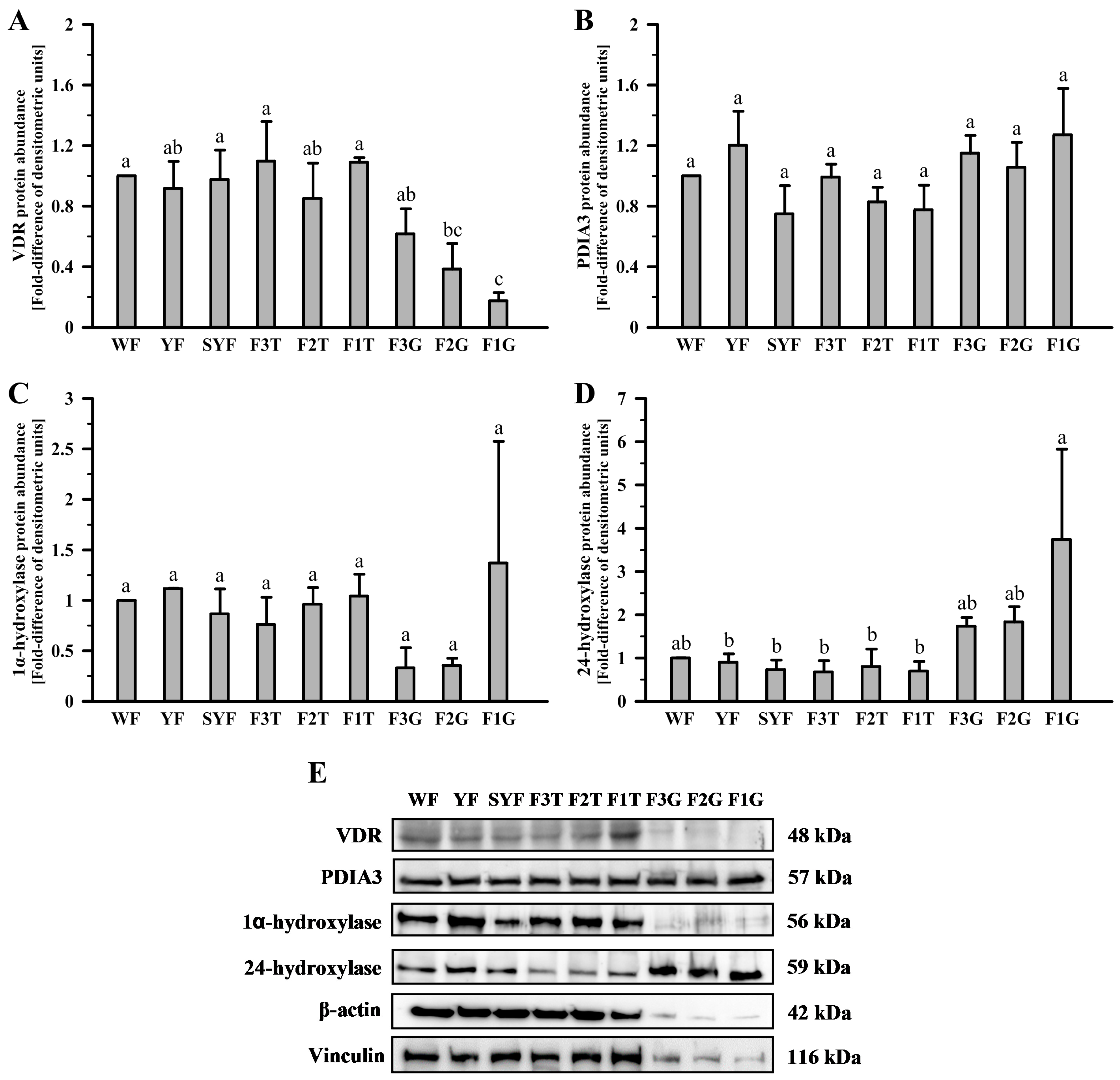
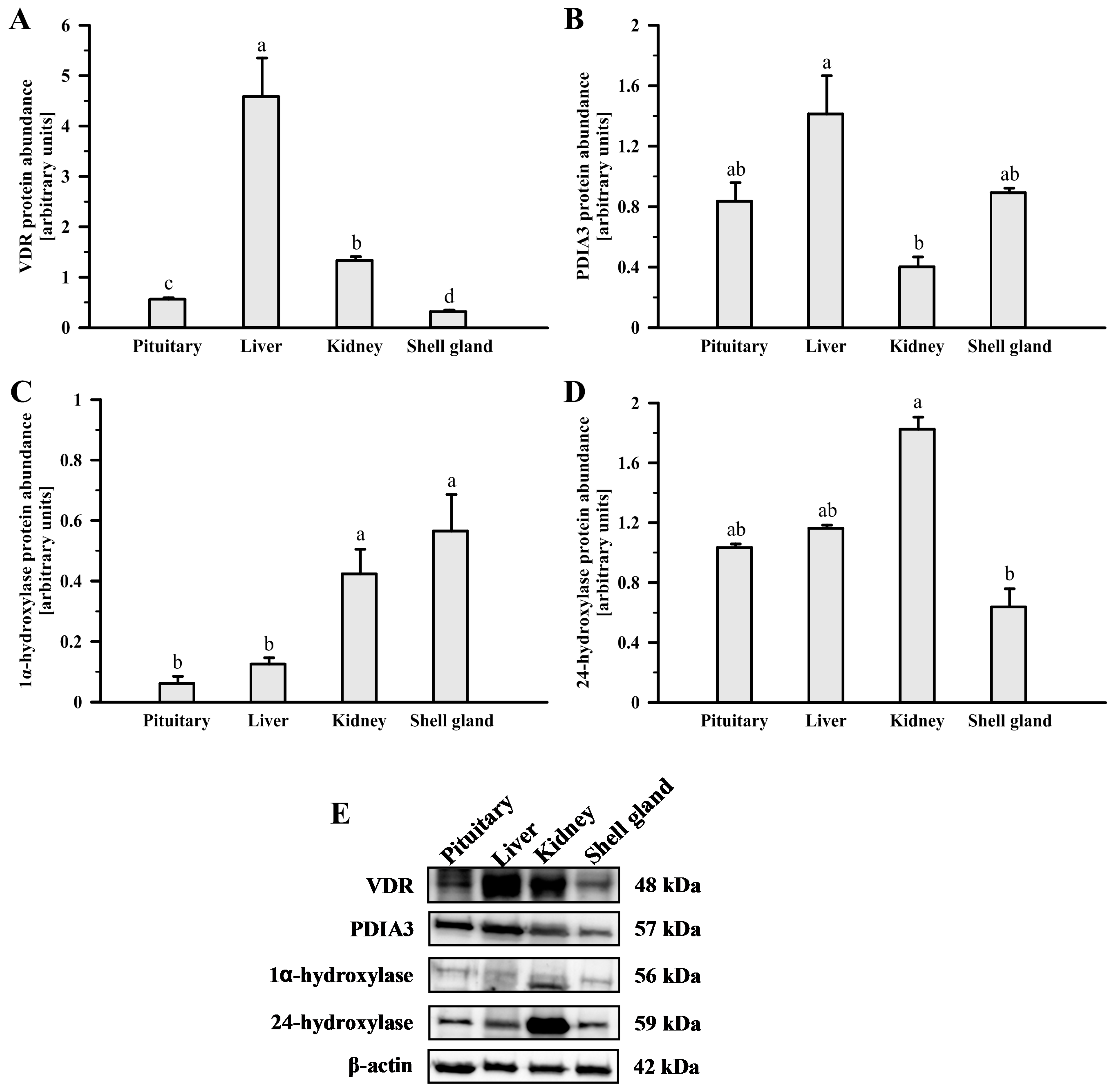
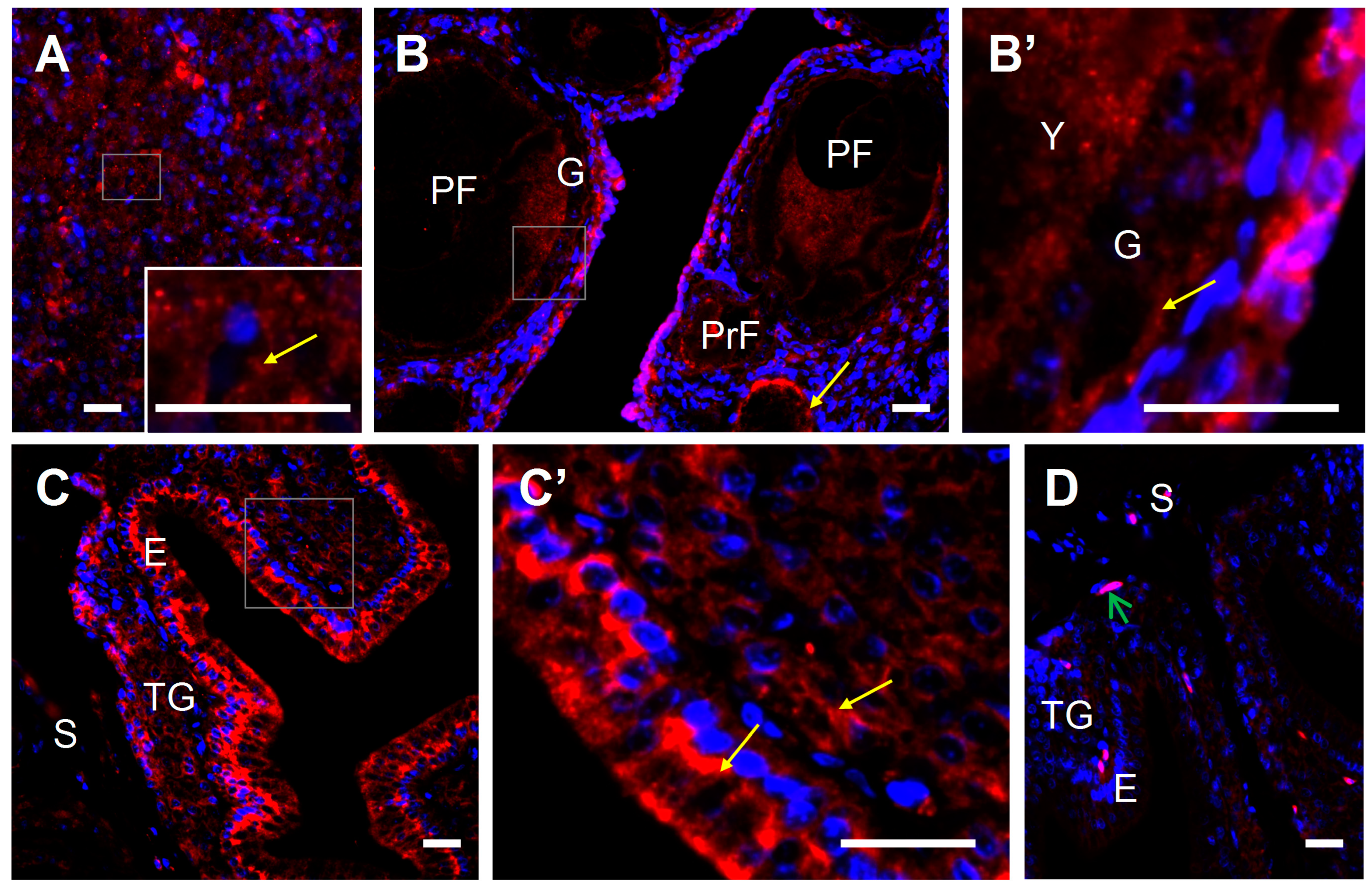
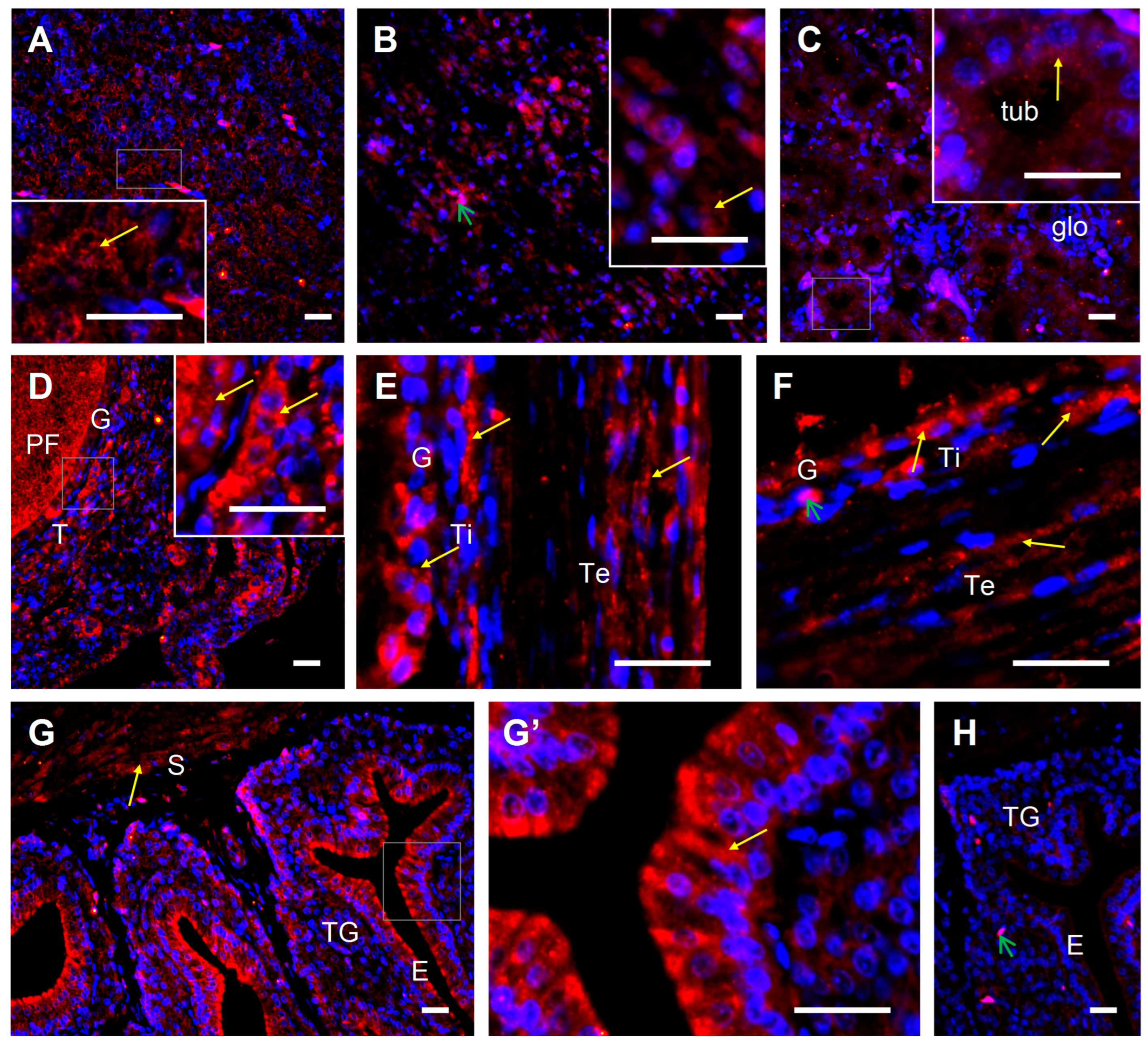
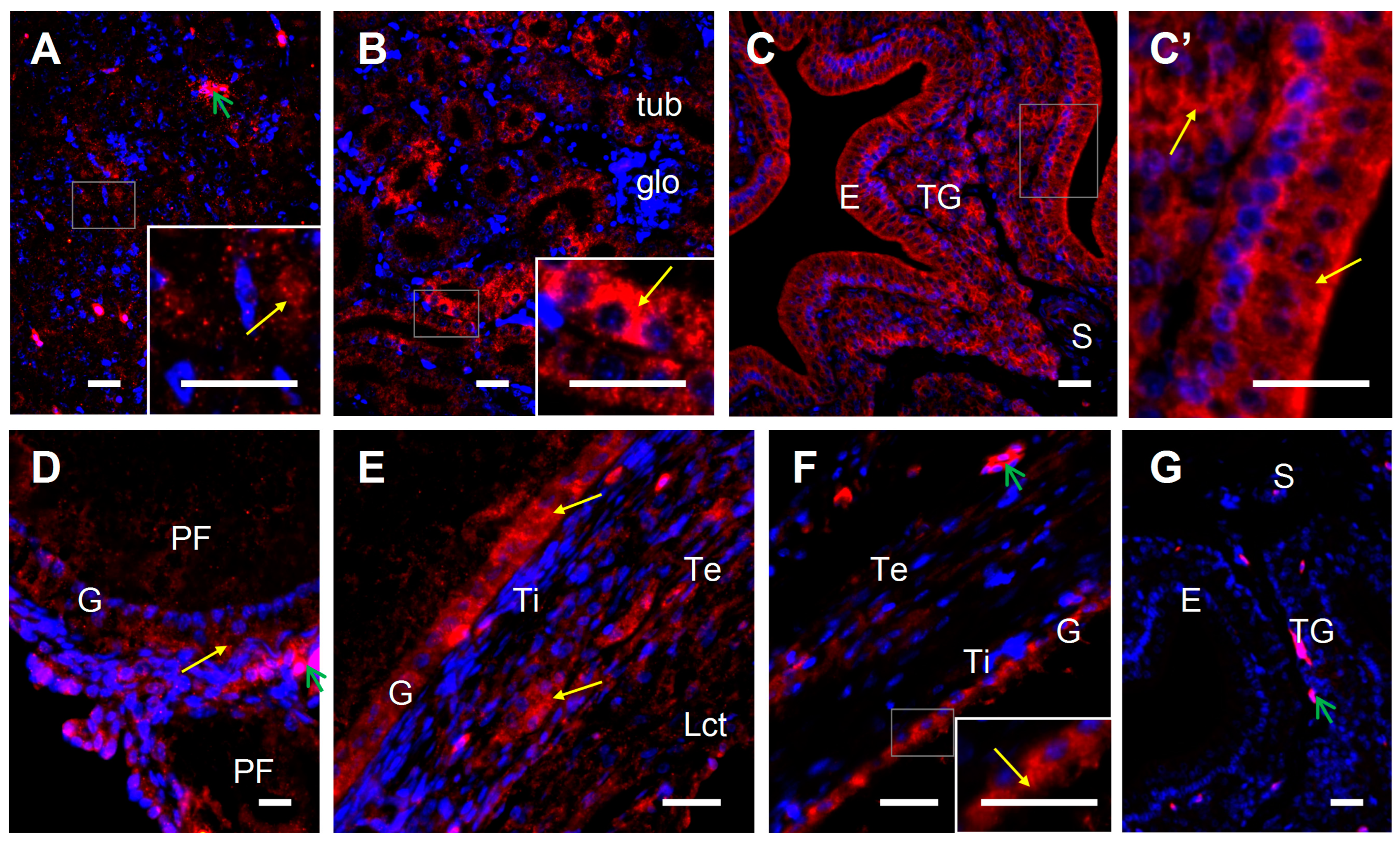
| Gene | GeneBank Identification | Assay ID | Amplicon Size [bp] |
|---|---|---|---|
| VDR | NM_205098.1 | Gg03348521_g1 | 80 |
| PDIA3 | NM_204110.3 | Gg03346843_m1 | 90 |
| CYP27C1 | XM_004942891.3 | Gg03326395_m1 | 107 |
| CYP24A1 | AF019142.1 | Gg03347931_m1 | 90 |
| 18S rRNA | X03205.1 | Cat. no. 4310893E | 187 |
| Antibody | Serum | Host Species | Vendor | Cat. No | WB Dilution | IF Dilution |
|---|---|---|---|---|---|---|
| Anti-VDR | 5% NGS | Rabbit | Cell Signaling, Massachusetts, DA, USA | 12550 | 1:1000 | 1:50 |
| Anti-PDIA3 | 5% NGS | Rabbit | Proteintech, Manchester, UK | 15967-1-AP | 1:5000 | 1:200 |
| 1α-hydroxylase | 5% NGS | Rabbit | Invitrogen, Carsband, CA, USA | PA5-79128 | 1:2000 | 1:200 |
| 24-hydroxylase | 5% NGS | Rabbit | Invitrogen, Carsband, CA, USA | PA5-79127 | 1:1000 | 1:150 |
| Anti-β-actin | - | Mouse | Sigma-Aldrich, St. Louis, MO, USA | A2228 | 1:4000 | - |
| Anti-vinculin | - | Mouse | Sigma-Aldrich, St. Louis, MO, USA | V9264 | 1:2000 | - |
| HRP-anti mouse IgG | - | Horse | Bio-Rad Laboratories Inc., GmbH, Munich, Germany | 170-6516 | 1:3000 | - |
| HRP-anti rabbit IgG | - | Goat | Invitrogen, Carsband, CA, USA | 31460 | 1:3000 | - |
| DyLight 594-anti rabbit | 5% NGS | Goat | Vector Laboratories, Burlingame, CA, USA | DI-1594-1.5 | - | 1:150 |
Disclaimer/Publisher’s Note: The statements, opinions and data contained in all publications are solely those of the individual author(s) and contributor(s) and not of MDPI and/or the editor(s). MDPI and/or the editor(s) disclaim responsibility for any injury to people or property resulting from any ideas, methods, instructions or products referred to in the content. |
© 2023 by the authors. Licensee MDPI, Basel, Switzerland. This article is an open access article distributed under the terms and conditions of the Creative Commons Attribution (CC BY) license (https://creativecommons.org/licenses/by/4.0/).
Share and Cite
Hrabia, A.; Kamińska, K.; Socha, M.; Grzesiak, M. Vitamin D3 Receptors and Metabolic Enzymes in Hen Reproductive Tissues. Int. J. Mol. Sci. 2023, 24, 17074. https://doi.org/10.3390/ijms242317074
Hrabia A, Kamińska K, Socha M, Grzesiak M. Vitamin D3 Receptors and Metabolic Enzymes in Hen Reproductive Tissues. International Journal of Molecular Sciences. 2023; 24(23):17074. https://doi.org/10.3390/ijms242317074
Chicago/Turabian StyleHrabia, Anna, Kinga Kamińska, Magdalena Socha, and Małgorzata Grzesiak. 2023. "Vitamin D3 Receptors and Metabolic Enzymes in Hen Reproductive Tissues" International Journal of Molecular Sciences 24, no. 23: 17074. https://doi.org/10.3390/ijms242317074
APA StyleHrabia, A., Kamińska, K., Socha, M., & Grzesiak, M. (2023). Vitamin D3 Receptors and Metabolic Enzymes in Hen Reproductive Tissues. International Journal of Molecular Sciences, 24(23), 17074. https://doi.org/10.3390/ijms242317074





